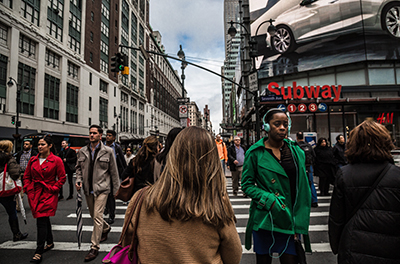Race and Income Segregation
Residents of Large Cities Have Less Exposure to People From Different Socioeconomic Backgrounds
While the United States is highly segregated by income, some suggest that densely populated cities may help bring people from different socioeconomic backgrounds into contact with one another. In Nature, IPR sociologist Beth Redbird and her colleagues test this hypothesis to understand the relationship between urbanization and segregation. The researchers collected mobile phone data tracking GPS locations of 9.6  million individuals, who could not be identified, from different socioeconomic statuses (SES) in the U.S., which the researchers estimated based on the average rent of a home where they lived. The data showed 1.6 billion encounters in people’s daily lives, which happened when two individuals crossed paths and were exposed to each other. The researchers then used the data to construct a dynamic network that measures exposure to segregation across 382 metropolitan areas and 2,829 counties. They find that in large cities, residents interact less with people from different socioeconomic backgrounds than in small cities because these cities offer more spaces targeted to specific socioeconomic groups, leading to more segregation. Their evidence also suggests that segregation may be mitigated in cities when “hubs,” or spaces that serve as bridges to people from high- and low-SES like a shopping center, are in between high- and low-income neighborhoods. The study sheds light on segregation in cities and how urban design could encourage socioeconomic mixing. Future research should examine cross-population differences in segregation and how urban design can reduce segregation.
million individuals, who could not be identified, from different socioeconomic statuses (SES) in the U.S., which the researchers estimated based on the average rent of a home where they lived. The data showed 1.6 billion encounters in people’s daily lives, which happened when two individuals crossed paths and were exposed to each other. The researchers then used the data to construct a dynamic network that measures exposure to segregation across 382 metropolitan areas and 2,829 counties. They find that in large cities, residents interact less with people from different socioeconomic backgrounds than in small cities because these cities offer more spaces targeted to specific socioeconomic groups, leading to more segregation. Their evidence also suggests that segregation may be mitigated in cities when “hubs,” or spaces that serve as bridges to people from high- and low-SES like a shopping center, are in between high- and low-income neighborhoods. The study sheds light on segregation in cities and how urban design could encourage socioeconomic mixing. Future research should examine cross-population differences in segregation and how urban design can reduce segregation.
Trends in Hiring Discrimination in Six Western Countries
While Western countries have established a legal framework and are publicly against discrimination, fair and equal treatment—regardless of race or ethnicity—has not been achieved in the workplace. In the Proceedings of the National Academy of Sciences, IPR sociologist Lincoln Quillian and his co-author, former Northwestern PhD student John Lee, investigate trends in racial and ethnic discrimination in hiring in six European and North American countries: Canada, France, Germany, Great Britain, the Netherlands, and the United States. The researchers analyze 90 field experimental studies of hiring discrimination against African/Black, Asian, Latin American/Hispanic, and Middle Eastern or North African groups, which include more than 170,000 applications for jobs. The country with the longest history of field experiments is Great Britain, with studies from 1969 to 2017. Germany has the shortest history, with studies ranging from 1994 to 2017. The researchers find that racial and ethnic discrimination in hiring has not declined significantly in the last 20–40 years in Canada, Germany, Great Britain, and the United States, but remained stable. Three exceptions to this were that hiring discrimination against ethnic groups with origins in the Middle East and North African increased after 2000, discrimination in France declined but from an unusually high starting point, and discrimination in the Netherlands increased over time. The results suggest that hiring discrimination in these countries stem from enduring stereotypes, prejudices, and racist ideology, despite hiring practices that aim to increase diversity. The researchers argue that future research into how to reduce persistent racial and ethnic biases in Western labor markets is needed.